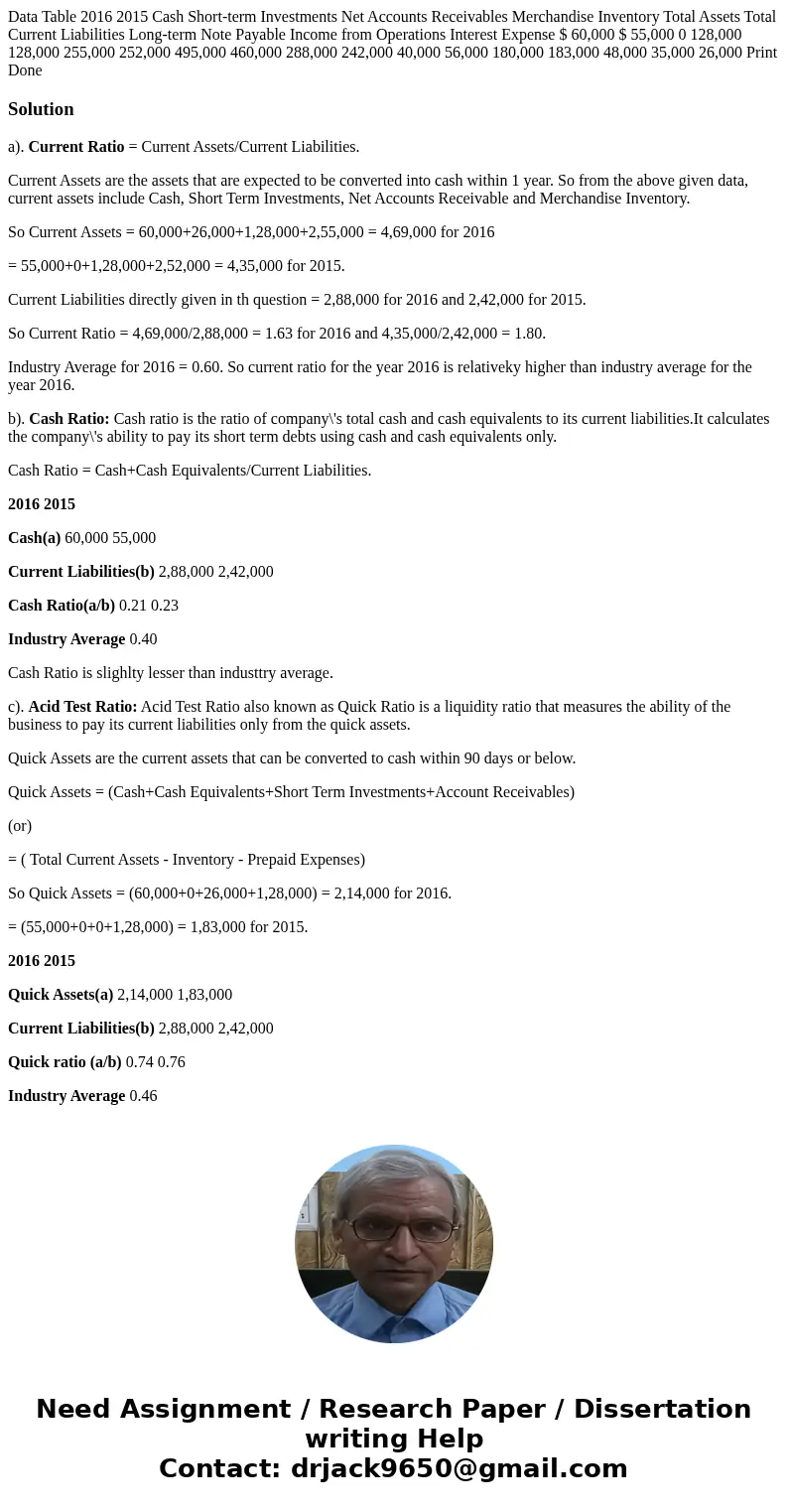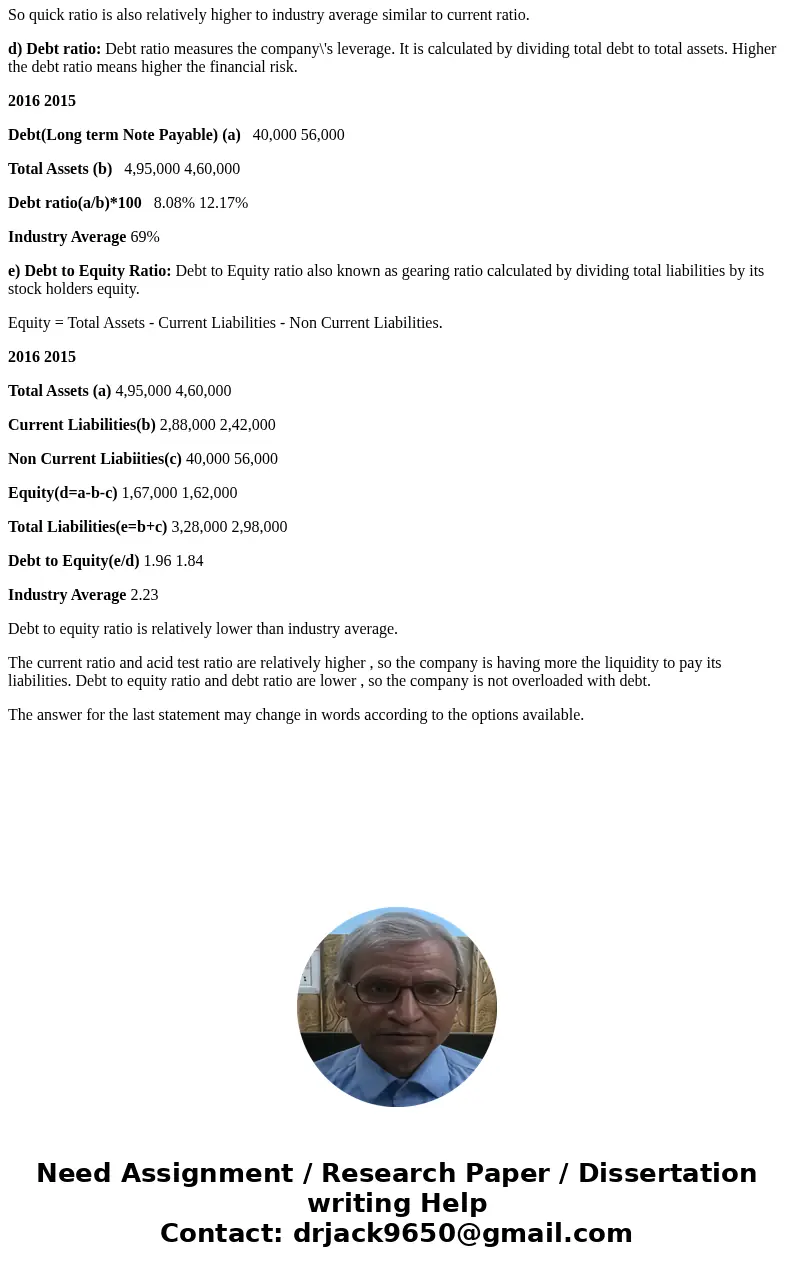Data Table 2016 2015 Cash Shortterm Investments Net Accounts
Solution
a). Current Ratio = Current Assets/Current Liabilities.
Current Assets are the assets that are expected to be converted into cash within 1 year. So from the above given data, current assets include Cash, Short Term Investments, Net Accounts Receivable and Merchandise Inventory.
So Current Assets = 60,000+26,000+1,28,000+2,55,000 = 4,69,000 for 2016
= 55,000+0+1,28,000+2,52,000 = 4,35,000 for 2015.
Current Liabilities directly given in th question = 2,88,000 for 2016 and 2,42,000 for 2015.
So Current Ratio = 4,69,000/2,88,000 = 1.63 for 2016 and 4,35,000/2,42,000 = 1.80.
Industry Average for 2016 = 0.60. So current ratio for the year 2016 is relativeky higher than industry average for the year 2016.
b). Cash Ratio: Cash ratio is the ratio of company\'s total cash and cash equivalents to its current liabilities.It calculates the company\'s ability to pay its short term debts using cash and cash equivalents only.
Cash Ratio = Cash+Cash Equivalents/Current Liabilities.
2016 2015
Cash(a) 60,000 55,000
Current Liabilities(b) 2,88,000 2,42,000
Cash Ratio(a/b) 0.21 0.23
Industry Average 0.40
Cash Ratio is slighlty lesser than industtry average.
c). Acid Test Ratio: Acid Test Ratio also known as Quick Ratio is a liquidity ratio that measures the ability of the business to pay its current liabilities only from the quick assets.
Quick Assets are the current assets that can be converted to cash within 90 days or below.
Quick Assets = (Cash+Cash Equivalents+Short Term Investments+Account Receivables)
(or)
= ( Total Current Assets - Inventory - Prepaid Expenses)
So Quick Assets = (60,000+0+26,000+1,28,000) = 2,14,000 for 2016.
= (55,000+0+0+1,28,000) = 1,83,000 for 2015.
2016 2015
Quick Assets(a) 2,14,000 1,83,000
Current Liabilities(b) 2,88,000 2,42,000
Quick ratio (a/b) 0.74 0.76
Industry Average 0.46
So quick ratio is also relatively higher to industry average similar to current ratio.
d) Debt ratio: Debt ratio measures the company\'s leverage. It is calculated by dividing total debt to total assets. Higher the debt ratio means higher the financial risk.
2016 2015
Debt(Long term Note Payable) (a) 40,000 56,000
Total Assets (b) 4,95,000 4,60,000
Debt ratio(a/b)*100 8.08% 12.17%
Industry Average 69%
e) Debt to Equity Ratio: Debt to Equity ratio also known as gearing ratio calculated by dividing total liabilities by its stock holders equity.
Equity = Total Assets - Current Liabilities - Non Current Liabilities.
2016 2015
Total Assets (a) 4,95,000 4,60,000
Current Liabilities(b) 2,88,000 2,42,000
Non Current Liabiities(c) 40,000 56,000
Equity(d=a-b-c) 1,67,000 1,62,000
Total Liabilities(e=b+c) 3,28,000 2,98,000
Debt to Equity(e/d) 1.96 1.84
Industry Average 2.23
Debt to equity ratio is relatively lower than industry average.
The current ratio and acid test ratio are relatively higher , so the company is having more the liquidity to pay its liabilities. Debt to equity ratio and debt ratio are lower , so the company is not overloaded with debt.
The answer for the last statement may change in words according to the options available.


 Homework Sourse
Homework Sourse